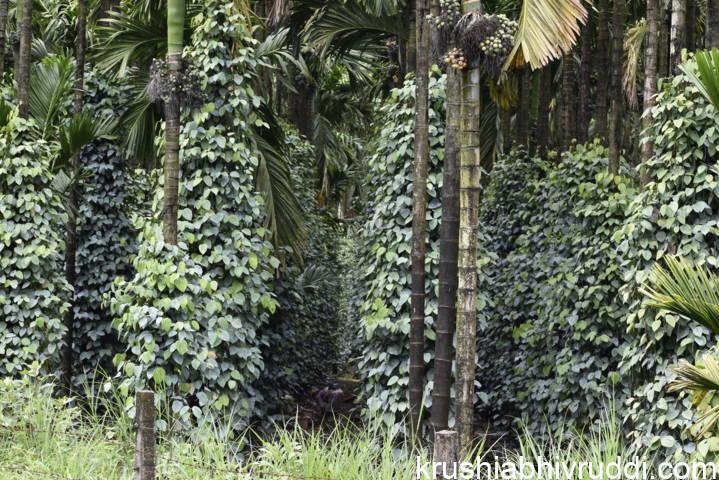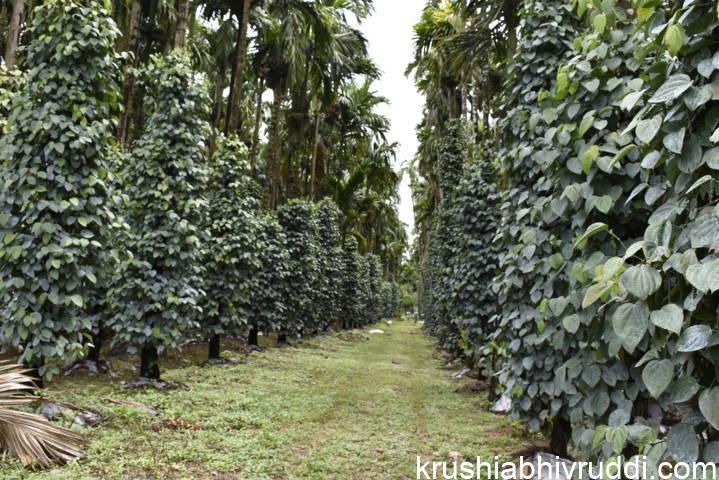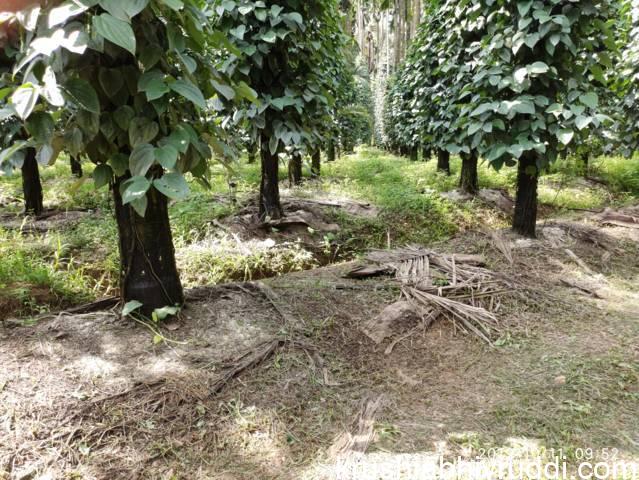This is the pepper and arecanut plantation of Mr Sudhir Balse, Chavatti, Yallapura taluk, Uttara Kannada dist. Karnataka. If anybody is traveled from Sirsi to Yallapura -Dandeli, by this root, they are all attracted by this glory of pepper crop along with arecanut garden. It will attract the people even he is not an agriculturist. A model areca garden mixed crop with pepper looks like Vietnam’s pepper gardens.
Mr. Sudhir Balse having around 10 acres of areca plantations. Among them in 70% of trees, he planted pepper and getting average 2 kg dry pepper per vine and 3 kg processed areca nut from a tree.
He says when we plant pepper along with areca nut tree definitely areca cultivation become profitable. Many visitors ask with Balse sir ‘how you maintain this? His answer is this. If we stick onto a single crop, the expenses occurring to maintain the garden is costlier. If we cultivate more crops, one crop will bare the expense of maintenance. Agriculture needs many inputs like manure, labor, plant protection etc. It is more than 70% of gross income. If we cultivate another crop it will enough for maintenance of main crop.
Almost all farmers cultivate pepper along with arecanut tree. But most of them are bitter experience in this because of disease etc. Her we can’t find savior diseases. If any symptoms noticed immediately he can take measures to cure it and survive the plant. We can ask with him the measures of maintaining pepper garden.

How he maintain the crop:
- From May onward he starts pepper vine management. In May month per a vine he put 1 Kg Dolomite lime,
- June and September it is must to provide recommended dose of fertilizers.
- As a organic manure he gives 5 kg of BHU CHITNYA prepared by arecanut growers of Sirsi.
- He is not applying FYM from last 5 years, because of no availability.
- As a plant protection Drenching of Copper oxi chloride COC in the month of June 2nd week and after 35 days of first application.
- If any problems noticed, he consult the concerned scientist, Dr. Vijayendra Hegade, of Horticlutre college Sirsi.
- He is following his advice from 1998 onwards to arecanut, after 2003 Balse started pepper cultivation, for this crop also he consult Dr V. M. Hegade.
- His suggestions uplifted Balse’s all crops.
- Here is an advantage that, The Totagars Co- Ope. society (TSS) and Taluka Marketing Society(TMS) gives agriculture inputs and also proper guidance to growers.
- Manuring is done depending upon the plant age.It is according to recommendations. ie.140:55:270 NPK.

Hight control in pepper cultivation:
- Many pepper growers leave the vine to grow maximum hight. But in his garden pepper vines are spreaded in limited heights.
- If it is old vine, its height is limited upto 22 feet.
- If it is younger its height is less.
- Height of the plant require excess nutrients.
- If we curb the height growth equal quantity of manuring is enough.
- In his experience this method will increases the yield.
- Here we find the controlled height in our Youtube video.
- If we prone the top portion, new shoots will emerge and it will stick tightly to support. Older vines detach the grip.

How to control Diseases:
- According to him – There was no definite reason for disease attack.
- Also there was no perfect solutions for disease control.
- By our cultivation practice and season oriented management will make the disease incidence very less.
- In earlier every year we are losing 6-7 % of pepper vines by diseases.
- Now we are started to put plastic mulching to tree base.
- It reduced the disease incidence to 1-2%.

- Excess Rain will effects the pepper crop more.
- We can’t do anything for rain.
- But we can do some arrangements to minimize the damage.
- In heavy rain season we have to spray 3 times instead of 2, regularly.
- In these cases we have to sacrifice with some percentage of profit margin for additional maintenance.
- It is essential to spray bourdox mixture two times in June and August. If required 3 spray also can be done.

- If there was excess crop in a year in that year incidence of disease or die back is more, it is because of shortage of food for the plant.
- In that year we have to supplement the nutrition through foliar sprays.
- It will helps a lot for survive the crop and vine.
- After September, up to the harvest minimum 3 foliar sprays of micro nutrients is essential.
- Addition of NPK nutrients in limited quantity also helps.

- Preventive measures to control the disease is removing lateral shoots at the base of vine.
- In May month removing all lateral shoots and dispose it far from the garden.
- Then in July month again it will sprouts.
- During that time cutting it and pasting the COC to wound part, will helps to control soil born disease.
- At bottom portion of vine we should not allow the leaf and shoot growth at least one feet.
- It prevents the soil born pathogen entry.
Drainage system:
- Pepper is very sensitive for excess water.
- This area is high rain fall area.
- So proper Drainage is essential.
- He made underground drainage at 3.5 feet under all his areca garden by placing holed PVC pipes.
- Along with for rain water drainage 1 feet open drainage is also required.
- Making the bottom slope type helps water drain immediately.

Irrigation system:
Both areca nut and pepper he irrigate through Drip irrigation. Pepper need not want much irrigation in May onwards. If excess irrigation given flowering will reduce. Daily recommended irrigation is 20-30 liter of water.
He also says, Pepper as an inter crop with areca plants is increases the yield of areca nut. We take much care to pepper vines by putting organic waste mulching and recommended dose of manures. Regular observation is also required. Automatically areca nut yield will increase.
Farmer’s Contact number:9663009087











